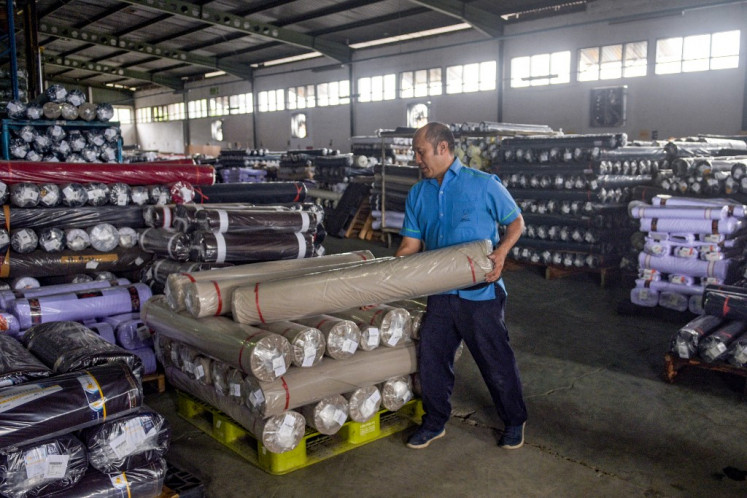Popular Reads
Top Results
Can't find what you're looking for?
View all search resultsPopular Reads
Top Results
Can't find what you're looking for?
View all search resultsCaptive breeding saves Bali starlings from poaching, extinction
Staying alive: A Bali starling in the West Bali National Park helps itself to food in the captive breeding area
Change text size
Gift Premium Articles
to Anyone
Staying alive: A Bali starling in the West Bali National Park helps itself to food in the captive breeding area. JP/ Desy Nurhayati
Widespread poaching of the endangered Bali starling has subsided and its population has started to grow again, thanks to individuals and conservation groups in Bali carrying out captive breeding of the bird species.
In the West Bali National Park, the passerine’s natural habitat and sanctuary, the population of the little white bird has slowly recovered through an intensive breeding campaign in the park followed by the newly-breds’ release into the wilderness.
Currently, the 19,000-hectare park nests between 80 and 90 starlings, up from around 15 in 2005, although the bird’s population in the wild has yet to reach an ideal level.
“The Bali starling remains on the IUCN’s [International Union for Conservation of Nature] list of ‘critically endangered’ species because its current population in the natural habitat is still low, but we have observed many improvements as a result of captive breeding,” said ornithologist Jarwadi B. Hernowo.
The lecturer at Bogor Agriculture Institute’s School of Forestry recently completed a two-year research project on the Bali starling in the Tanjung Gelap area, in the West Bali National Park.
Ideally, there should be 500 birds in the park, he said, adding that a species was listed as “critically endangered” based on its situation in the wild, not in captive sites.
“Although most of the Bali starlings we see now are bred in captivity, and not in the wild, the [breeding] campaign has helped save the species from extinction.”
Captivate breeding has also curbed poaching.
“Poaching is not as widespread as several years ago, when the Bali starling could hardly be found outside its natural habitat. With more people breeding the species nowadays, the population [of starling] has increased, making the bird less expensive to buy,” Jarwadi said.
According to Jarwadi, Bali starlings were worth between Rp 30 and Rp 40 million (US$3,200) each five years ago. The price has now decreased to between Rp 7 and 15 million each, but breeding starlings remains a lucrative business.
“Intensifying captive breeding is one of the ways to tackle poaching, because if there is not enough
supply [of starlings] in the market, then poachers will grab what they can from the wild [endangered] population.”
Gusti Komang Suardika, a forest ranger in the Brumbun area of the national park, confirmed there was no poaching in the 3,000-hectare site, home to 15 Bali starlings.
“We haven’t seen any poaching in the last couple of years. The population [of starlings] is not rising is because of predators, especially eagles, civets and lizards,” he said.
“The last time we saw a poaching here was in 2004,” said Nana Rukmana, an officer in the park’s Tegal Bunder area.
The center of breeding at the national park is in Tegal Bunder, while Brumbun serves as a releasing site.
Captive breeding in the national park started in 1996. The captive-bred starlings were first released in 1998. In that year, 20 starlings were hatched and 32 were released into the wild.
“Every year, half of the hatched starlings will be released into the wild in the same year, 30 percent of them set aside for breeding purposes, while the remaining 20 percent will be released the following year,” Nana said.
To increase reproduction, the park management usually brings some starling mothers from other captive sites to breed with those already in the park.
In Tegal Bunder, cages differ. Breeding cages tend to be used for mature starling couples that have entered their reproductive ages — usually after six months. Once the offspring is 35 days old, they are weaned from their mothers and assigned to a separate cage.
When they turn three months old, birds to be released are put in separate cages from those used for breeding purposes.
“Bali starlings like to be in groups of between three and five,” Nana said.
“Before the birds are released, we conduct a health check to ensure they are in good condition,” he said.
Head of the national park Bambang Darmadja said the park management monitored the starlings on a regular basis once they were released into the wild.
“We have a team of 17 tasked with tracking the birds’ movements and how they survive after they are released.”
“We have also improved the quality of their habitat by planting seeds to provide them with enough food, and by making nest boxes to give places to rest and lay eggs.”










